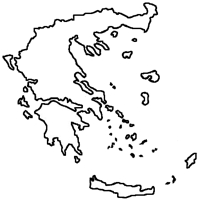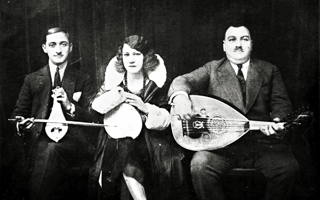
|
The Society of Folk Dance Historians (SFDH)
Rebetika
[
Home |
About |
Encyclopedia | CLICK AN IMAGE TO ENLARGE |

|
A Transition from Tradition to Modernity
 Greece has been endowed with several distinct aspects of cultural diversity, but there is doubt as to what was truly Greek in the past and what is still inherently part of the contemporary expression. There have been several attempts to find the identity that would speak for these people as being connected with the ancient people and their glories, or just another pastoral agricultural society abandoned on the Balkan Peninsula.
Greece has been endowed with several distinct aspects of cultural diversity, but there is doubt as to what was truly Greek in the past and what is still inherently part of the contemporary expression. There have been several attempts to find the identity that would speak for these people as being connected with the ancient people and their glories, or just another pastoral agricultural society abandoned on the Balkan Peninsula.
With the development of a new society after several political upheavals in the early 1900s, there was a beginning or a change from the rural concentrations to the urban center. Along with the political skirmishes, the industrialization brought refugees into these urban centers like Piraeus, Athens, and Thessaloniki. This new "working class" found refuge in their "deke" (underground clubs) where they could express their frustrated voices in song and dances depicting their debilitating lifestyle. These expressions differ from the Greek peasantry still hovering in their villages, emerged with fresh energy; from the factory or dock worker there were strained signs of his strife as he longed to re-identify having left the confines of Asia Minor.
With the bouzouki in their hands, an evolving instrument of the "baglama," the Rebetiko song was taking shape. The music, like reminiscing echoes of the Byzantine chant, mixed with the musical styles of the Near East and often associated with negative social context and habitues of hashish parlors, these Rebetes with their wailing lyrics of either pain or defiance, agonized or rejected lovers, danced to the ancient traditional dances of the Zembebiko, and the Hasapiko with sexually provocative Tsiftateli that sought to evoke a positive condition from the deep confines.
At first the Rebetika were rejected by society as being non-Greek, leaning heavily on Turkish influences. Their association with the "low-life" brought on and even greater rejection by a new nation that sought to find its place on the European continent. Though the strivings of the Greek culture often reverted to some European accepted form of music and the vestiges of the shepherd still hanging on to his folk song and dance, there was a distinct condemnation for both by the newly-formed society that officially represented Greece. Despite this, the Rebetika thrived and continued to spread throughout the mainstream of emerging cities. It even crept into the newer social classes through still echoing negative personal and social values – an undertone of deep anxiety.
 Here, finally we see the creation of a new "folk art" shaped from the subtle emergence of the unskilled workers, laborers from the poor neighborhoods and ghettos who have been permanently deprived of their native land. With the continuing success in the 1940s and 1950s, they now began to borrow from the traditional songs of rural Greece. What was once the security blanket for some outcasts now became a voice of vibrant culture that stepped up its acceptance more and more into a serious art form, becoming the spokesman for the Greek abroad, from the war years when the Greek would sing, "A man enjoys his dancing, and that of his companions . . ." and would go on with, "Tonight at the tavern, God knows what will happen. And if you get up and dance, no glass will be left unbroken."
Here, finally we see the creation of a new "folk art" shaped from the subtle emergence of the unskilled workers, laborers from the poor neighborhoods and ghettos who have been permanently deprived of their native land. With the continuing success in the 1940s and 1950s, they now began to borrow from the traditional songs of rural Greece. What was once the security blanket for some outcasts now became a voice of vibrant culture that stepped up its acceptance more and more into a serious art form, becoming the spokesman for the Greek abroad, from the war years when the Greek would sing, "A man enjoys his dancing, and that of his companions . . ." and would go on with, "Tonight at the tavern, God knows what will happen. And if you get up and dance, no glass will be left unbroken."
With the unprecedented success and growing popularity of the Rebetika, they were no longer serving only the isolated ghettos. They instead grew to develop a national audience. Success, however, also brought a decline in the form as it strived to borrow from other sources of music, mixing the musical styles and instrumentation. It was fatal that the purity of the Rebetika would remain as meaningful and powerful as its inception, and thus its decline as a folk art was inevitable.
Through various changes in Greece through the 1960s and 1970s the Greek youth of the 1980s sought to redefine his role in society. After succumbing during the post-war years to European and American influences, they began to to assert themselves in a movement that would return their Greek identity. In pursuing this, particularly amongst the intelligentia and university students, the evaluation of the Greek is to get hold of his roots and understand his immediate culture and that which has been closest, that is both the Greek folklife of rural Greece, and the Rebetika which shaped so much of what today and still survives.
Several bouzouki bands such as the Rebetiki Compania have appeared on the scene seeking to authenticate the sound of the early bouzouki without amplification, sincerity of lyric, and style of instrumentation and orchestration. The Rebetiki Compania has toured the United States and various countries in Europe and what a paradox that not long ago the official sources sought to squelch the spreading of this "art form." Now it seeks and is officially condoned by the Ministry of Culture. But this is only a nostalgic reprise. Folk music at best, thrives when the form is generating interest at the moment of birth, and speaks to a people at that very time. What will be the Rebetika's fate in the future is a big question, for the approach to the material today is not from the same social needs as in the past. Such an art seeks to speak directly to its contemporaries.
A people with very real needs seek an expression and discover a voice in music that must be intoned with the celebrated struggle of a people connected with the material. In the hands of young musicians and untrained folk musicians, a tradition can be born through the imagery of the folk artist who seeks to find definition in his life be it in art, music, song, or dance. But when these forms are placed in the hands of the skilled artisan and craftsman, a conscious art form is born that speaks to an audience whose needs are different. They are looking for recreation and leisurely entertainment, as opposed to often bitter agony of screaming within.
DOCUMENTS
- Athan Karras, an article.
- Greece, a country.
Printed in Folk Dance Scene, July/August 1986.
This page © 2018 by Ron Houston.
Please do not copy any part of this page without including this copyright notice.
Please do not copy small portions out of context.
Please do not copy large portions without permission from Ron Houston.